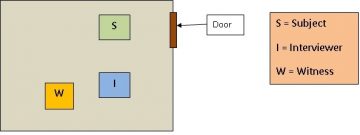
Sometimes we have to do things we are not always comfortable with. Hey, really that’s just life. This topic may seem elementary to the interview dynamic, but from training and research we see novices and experienced interviewers not doing what is best, and they have plenty of reasons/excuses.
Despite what some may ignore, the arrangement of interview room remains an important aspect toward success in your interviews. Strategizing how to maximize the set up is something we should always consider be it a victim, witness, or subject interview. This strategizing should be done before and throughout the interview. This dynamic applies to criminal investigations, administrative, audits, and any important interactions you intend to have.
When setting up a room for conducting an interview, there are a few basic rules the interviewer should keep in mind. Aside from making the interviewee feel as comfortable as possible, the interview room should also facilitate clear communication, including non-verbal. This means that physical barriers should be minimized between the interviewee that might block the interviewer’s view of them.
There are good reasons for this. Firstly, a physical barrier, such as a table, can act as a psychological barrier. In a situation in which open communication is sought, putting up barriers obviously goes against the goal. Those barriers serve to diminish the effect of rapport, which is something that must be maximized throughout the interview process.
Another reason to keep furniture out of the way is to provide the interviewer with a full-body view of the interviewee. This is important when assessing their body language, or non-verbal clues, when he or she is answering questions and providing detail about the incident in question.
Now recognize when minimizing barriers, not only is the interviewee exposed, so are we. As a result, it is incumbent on us as the interviewer to minimize non-verbal behavior that would be distracting, demonstrate a lack of confidence, or negatively affect the facilitation of clear communication. Although not often admitted this is one of the main reasons interviewers rear up against this best practice. When I interview, one of the main responsibilities of my secondary is to make sure I am not adversely effecting the interviewee.
How important is it? In one homicide case I examined the impact was clear and very revealing. At one point of the interview, the detective moved the table in the room out of the way and pulled up in front of the suspect and continued questioning. Later, after sentencing, the suspect was shown that scene and asked his thoughts. He responded that at that point he was concerned that “his guilt would show.” How interesting; it wouldn’t be his guilt that showed, but that is how he processed it. He went on to say that he knew he was bouncing his foot and now he needed to control that. What we know is that some of these physical actions are clearly connected to psychological thoughts and cognitive activity.

When we set the room up, or use a room, we want to minimize barriers in the room. What are those barriers? Desks, conference tables, low sofas, and just think what else you run into. Anything that interferes with seeing the whole person or giving that person a place to “hide.” With someone sitting behind a desk, you lose 50% of body observation if you are sitting across from them. That is the physical aspect, but what about the psychological aspect of them feeling comfortable, protected, and secure behind their desk. We need to change the dynamic to increase cognitive load by removing barriers, which increases our ability to read and detect deception..
Ideally, as reflected in the diagram above, we allow them access to the door. (Note: Not necessarily a custodial interview.) We sit at a conversational distance (4 foot or less) directly in front of them, and if we have a witness or secondary, have them sit off to the side and a little further back. Personally, I like to use a chair with wheels and the interviewee on a stationary chair so that I have the ability to close or increase the distance as necessary. However, if you can’t sit still in a chair with wheels, don’t use it, as that can be seriously distracting.
Other things we want to consider:
- What is the size of the room, is it too big for effective communication?
- Are there windows in the room? Don’t arrange the room so that the interviewee is looking out a window. This often allows them to “feel” like they can escape the interview.
- How many people will be present in the interview room, and how do we minimize unwanted participation?
- How do we control the room when we are at their location?
There are so many more elements we could discuss and should consider. But first things first…..get out from behind your barriers!
Anderson Investigative Associates is positioned to custom tailor training to your specific needs. If you have any questions, or would like to discuss the above blog or any training need, please reach out to me. Additional issues pertaining to interviewing and investigations can be found in other blogs that I have written and are contained in most blocks of instruction that our company presents.
If you have additional questions or comments, give me a shout. In the meantime, be well and be safe out there.
Mark A. Anderson
Director of Training and Development
Anderson Investigative Associates, llc
128 Oarsman Xing
St. Marys, GA 31558
manderson@andersoninvestigative.com
tel:912-882-5857
tel:912-571-6686
